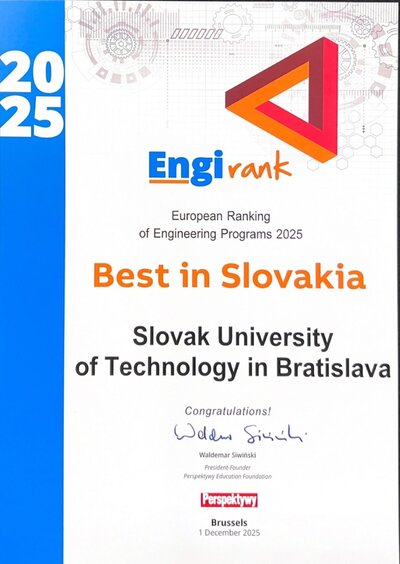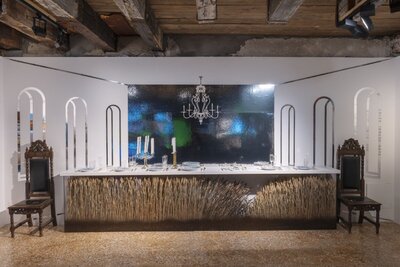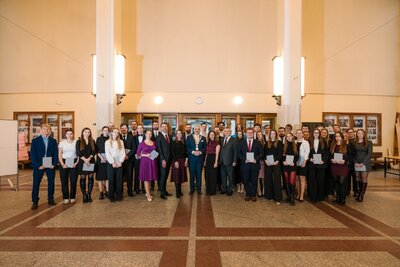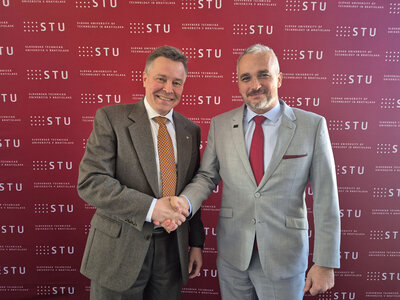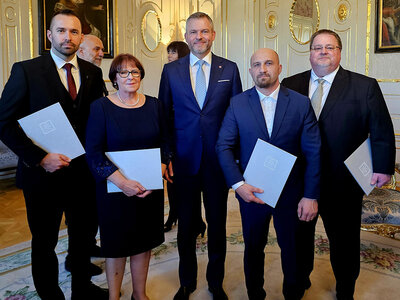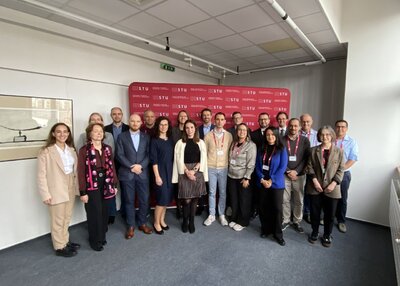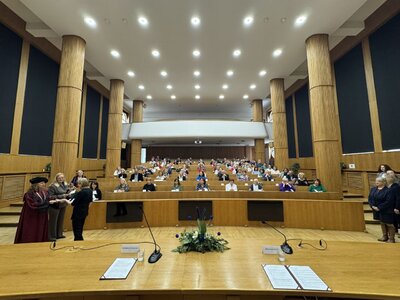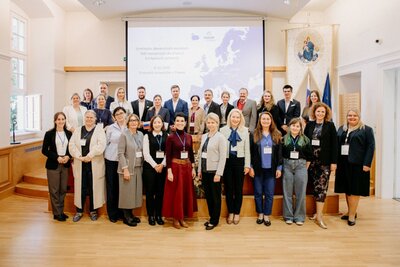Integrované fotovoltické fasády budov
Ing. Jakub Čurpek, PhD.
jakub.curpek@stuba.sk
Katedra konštrukcií pozemných stavieb
Stavebná fakulta
Slovenská technická univerzita v Bratislave
Abstract:
Building-integrated photovoltaic systems (BIPV) are increasingly used in modern construction and are expected to become an essential part of sustainable building design. This study material offers a basic overview of how photovoltaic systems can be integrated into building façades, along with key architectural and research trends shaping this field. The main idea is that we shouldn't see a building's façade only as a design feature, but also as a chance to use renewable energy. The text encourages thinking about new ways to apply these systems, not just for generating electricity. Hybrid systems and their ongoing development are expected to be used more often in the building industry.
DOI: 10.61544/FWDW3261
Literatúra:
[1] T. Yang, W. Liu, G.J. Kramer, Q. Sun, Seasonal thermal energy storage: A techno-economic literature review, Renewable and Sustainable Energy Reviews 139 (2021) 110732. https://doi.org/10.1016/J.RSER.2021.110732.
[2] Smernica - 2018/2001 - EN - EUR-Lex, https://eur-lex.europa.eu/legal-content/sk/TXT/?uri=CELEX%3A32018L2001.
[3] Ako EÚ podporuje obnoviteľné zdroje energie?, Https://Www.Europarl.Europa.Eu/Topics/Sk/Article/20221128STO58001/Ako-Eu-Podporuje-Obnovitelne-Zdroje-Energie.
[4] Solar PV and wind supply about 40% of building electricity use by 2030 – Analysis - IEA, https://www.iea.org/reports/solar-pv-and-wind-supply-about-40-of-building-electricity-use-by-2030.
[6] ÚRSO: Podiel „zelenej elektriny“ na celkovej výrobe elektriny v SR je na úrovni 22,90 % | Úrad pre reguláciu sieťových odvetví, https://www.urso.gov.sk/urso-podiel-zelenej-elektriny-na-celkovej-vyrobe-elektriny-v-sr-je-na-urovni-2290-/.
[7] Zákon č. 555/2005 Z. z. o energetickej hospodárnosti budov a o zmene a doplnení niektorých zákonov, n.d.
[8] Návrh - NÁRODNÝ PLÁN ZAMERANÝ NA ZVYŠOVANIE POČTU BUDOV S TAKMER NULOVOU POTREBOU ENERGIE, Https://Energy.Ec.Europa.Eu/Document/Download/98310432-F449-4032-88d8-04fe47362ff7_en?Filename=slovak_republic_sk_version.Pdf&prefLang=sk.
[9] Vyhláška č. 35/2020 Z. z. ktorou sa mení a dopĺňa vyhláška Ministerstva dopravy, výstavby a regionálneho rozvoja SR č. 364/2012 Z. z., ktorou sa vykonáva zákon č. 555/2005 Z. z. o energetickej hospodárnosti budov a o zmene a doplnení niektorých zákonov v znení neskorších predpisov v znení vyhlášky. č.324/2016 Z. z., n.d.
[10] Vyhláška č. 364/2012 Z. z. Slovenskej republiky, Vyhláška Ministerstva dopravy, výstavby a regionálneho rozvoja Slovenskej republiky z 12.novembra 2012, ktorou sa vykonáva zákon č. 555/2005 Z. z. o energetickej hospodárnosti budov a o zmene a doplnení niektorých zákonov v znení neskorších predpisov., n.d.
[11] Vyhláška č. 324/2016 Z. z. Slovenskej republiky, Vyhláška Ministerstva dopravy, výstavby a regionálneho rozvoja Slovenskej republiky z 30.novembra 2016, ktorou sa mení a dopĺňa vyhláška Ministerstva dopravy, výstavby a regionálneho rozvoja Slovenskej republiky č. 364/2012 Z. z., ktorou sa vykonáva zákon č. 555/2005 Z. z. o energetickej hospodárnosti budov a o zmene a doplnení niektorých zákonov v znení neskorších predpisov., n.d.
[12] K.D. Jäger, et al., Solar energy : fundamentals, technology and systems, UIT Cambridge, 2016.
[13] R. Haselhuhn, Fotovoltaika – Budovy jako zdroj proudu., Nakladateľstvo HEL, 2010.
[14] B.P. Jelle, C. Breivik, H. Drolsum Røkenes, Building integrated photovoltaic products: A state-of-the-art review and future research opportunities, Solar Energy Materials and Solar Cells 100 (2012) 69–96. https://doi.org/10.1016/J.SOLMAT.2011.12.016.
[15] J.A. Duffie, W.A. Beckman, Solar Engineering of Thermal Processes: Fourth Edition, Solar Engineering of Thermal Processes: Fourth Edition (2013). https://doi.org/10.1002/9781118671603.
[16] J.H.C. Hendricks, The option of phase change materials as temperature regulation for building integrated photovoltaics, (2010). https://studenttheses.uu.nl/handle/20.500.12932/5813 (accessed January 8, 2025).
[17] B.P. Jelle, Building Integrated Photovoltaics: A Concise Description of the Current State of the Art and Possible Research Pathways, Energies 2016, Vol. 9, Page 21 9 (2015) 21. https://doi.org/10.3390/EN9010021.
[18] Best Research-Cell Efficiency Chart | Photovoltaic Research | NREL, (n.d.). https://www.nrel.gov/pv/cell-efficiency.html (accessed January 9, 2025).
[19] STN 33 2000-7-712: 2022 Elektrické inštalácie nízkeho napätia. Časť 7-712: Požiadavky na osobitné inštalácie alebo priestory. Fotovoltické (PV) systémy. November 2022, n.d.
[20] https://solaro.sk/p/solarny-predlzovaci-kabel-4mm%C2%B2-s-mc4-konektormi/.
[21] https://www.slocable.com.cn/sk/solar-panel-wiring-diagram/.
[22] https://solaro.sk/p/rozvodna-skrina-pv-1000-dc-ac-2-stringy-skridla.
[23] Úrad pre reguláciu sieťových odvetví. Porovnanie podpory OZE a výkupných cien elektriny vyrobenej z OZE v okolitých krajinách. Odbor monitoringu a analýz, Martin, júl 2016.
[24] Vyhláška č. 18/2017 Z. z. ktorou sa ustanovuje cenová regulácia v elektroenergetike a niektoré podmienky vykonávania regulovaných činností v elektroenergetike.
[25] Vyhláška č. 18/2017 Z. z. Slovenskej republiky, Vyhláška Úradu pre reguláciu sieťových odvetví z 8. februára 2017, ktorou sa ustanovuje cenová regulácia v elektroenergetike a niektoré podmienky vykonávania regulovaných činností v elektroenergetike.
[26] ZSE Fotovolt Štandard 4 kW | ZSE, https://www.zse.sk/produkty/fotovoltika/zse-fotovolt-standard-4-kw.
[27] JRC Photovoltaic Geographical Information System (PVGIS) - European Commission, (n.d.). https://re.jrc.ec.europa.eu/pvg_tools/en/.
[28] Fotovoltika na strechách – Krytina.sk, https://krytina.sk/magazin/novostavba/fotovoltika-na-strechach.
[29] https://solaro.sk/p/nosna-konstrukcia-pre-20-panelov-na-sikmu-strechu-zo-skridle/.
[30] J. Benemann, O. Chehab, E. Schaar-Gabriel, Building-integrated PV modules, Solar Energy Materials and Solar Cells 67 (2001) 345–354. https://doi.org/10.1016/S0927-0248(00)00302-0.
[31] Fasáda školy vyrába elektrinu zo slnečných lúčov | iStavebnictvo.sk, (n.d.). https://www.istavebnictvo.sk/clanky/fasada-skoly-vyraba-elektrinu-zo-slnecnych-lucov.
[32] B.P. Jelle, C. Breivik, H. Drolsum Røkenes, Building integrated photovoltaic products: A state-of-the-art review and future research opportunities, Solar Energy Materials and Solar Cells 100 (2012) 69–96. https://doi.org/10.1016/J.SOLMAT.2011.12.016.
[33] E. Skoplaki, J.A. Palyvos, On the temperature dependence of photovoltaic module electrical performance: A review of efficiency/power correlations, Solar Energy 83 (2009) 614–624. https://doi.org/10.1016/J.SOLENER.2008.10.008.
[34] International Energy Agency (IEA), Potential for Building Integrated Photovoltaics. IEA: Ursen, Switzerland, 2002; p. 1–12, n.d.
[35] P.R. Defaix, W.G.J.H.M. van Sark, E. Worrell, E. de Visser, Technical potential for photovoltaics on buildings in the EU-27, Solar Energy 86 (2012) 2644–2653. https://doi.org/10.1016/J.SOLENER.2012.06.007.
[36] A.G. Imenes, D.R. Mills, Spectral beam splitting technology for increased conversion efficiency in solar concentrating systems: a review, Solar Energy Materials and Solar Cells 84 (2004) 19–69. https://doi.org/10.1016/J.SOLMAT.2004.01.038.
[37] O. Dupré, R. Vaillon, M.A. Green, Thermal behavior of photovoltaic devices: Physics and engineering, Thermal Behavior of Photovoltaic Devices: Physics and Engineering (2016) 1–130. https://doi.org/10.1007/978-3-319-49457-9/COVER.
[38] O. Dupre, Physics of the thermal behaviour of photovoltaic devices. Ph.D. Thesis, INSA de Lyon, 2015.
[39] Integrácia fotovoltaických systémov do budov | ASB.sk, https://www.asb.sk/stavebnictvo/technicke-zariadenia-budov/integracia-fotovoltaickych-systemov-do-budov.
[40] Najlepšia orientácia a sklon fotovoltických panelov | embu.sk, Https://Www.Embu.Sk/ (n.d.). https://www.embu.sk/solarna-energia/najlepsia-orientacia-a-sklon-fotovoltickych-panelov/.
[41] IEC 63092-1:2020 Photovoltaics in buildings - Part 1: Requirements for building-integrated photovoltaic modules.
[42] EN 50583-1 Photovoltaics in buildings - Part 1: BIPV modules, January 2016.
[43] NARIADENIE EURÓPSKEHO PARLAMENTU A RADY (EÚ) č. 305/2011 z 9. marca 2011, ktorým sa ustanovujú harmonizované podmienky uvádzania stavebných výrobkov na trh a ktorým sa zrušuje smernica Rady 89/106/EHS.
[44] SMERNICA EURÓPSKEHO PARLAMENTU A RADY 2006/95/ES z 12. decembra 2006 o harmonizácii právnych predpisov členských štátov týkajúcich sa elektrického zariadenia určeného na používanie v rámci určitých limitov napätia.
[45] EN 50583-2 Photovoltaics in buildings - Part 2: BIPV systems, January 2016, n.d.
[46] K. Berger, et al., International definitions of “BIPV” , IEA PVPS Task 15 Subtask C – International framework for BIPV specifications Report IEA-PVPS T15-04: 2018 August 2018 , 2018.
[47] Guide to Sustainable Building Certifications, Published by Sbi and GXN, 2018, ISBN: 978-87-563-1881-5.
[48] G.Y. Yun, M. McEvoy, K. Steemers, Design and overall energy performance of a ventilated photovoltaic façade, Solar Energy 81 (2007) 383–394. https://doi.org/10.1016/J.SOLENER.2006.06.016.
[49] Photovoltaik Fassaden: Leitfaden zur Planung. LITHODECOR Innovative Fassadensysteme,2016, DAW SE und GWT-TUD GmbH, ISBN: 978-3-86780-463-9.
[50] https://www.3s-solar.swiss/blog/anforderungen-brandschutz.
[51] G.Y. Yun, M. McEvoy, K. Steemers, Design and overall energy performance of a ventilated photovoltaic façade, Solar Energy 81 (2007) 383–394. https://doi.org/10.1016/J.SOLENER.2006.06.016.
[52] Z. Nagy, B. Svetozarevic, P. Jayathissa, M. Begle, J. Hofer, G. Lydon, A. Willmann, A. Schlueter, The Adaptive Solar Facade: From concept to prototypes, Frontiers of Architectural Research 5 (2016) 143–156. https://doi.org/10.1016/J.FOAR.2016.03.002.
[53] https://www.ertex-solar.at/.
[54] https://www.schueco.com/.
[55] T.E. Kuhn, C. Erban, M. Heinrich, J. Eisenlohr, F. Ensslen, D.H. Neuhaus, Review of technological design options for building integrated photovoltaics (BIPV), Energy Build 231 (2021) 110381. https://doi.org/10.1016/J.ENBUILD.2020.110381.
[56] https://www.3s-solar.swiss/bildergalerie.
[57] T. Yang, A.K. Athienitis, A review of research and developments of building-integrated photovoltaic/thermal (BIPV/T) systems, Renewable and Sustainable Energy Reviews 66 (2016) 886–912. https://doi.org/10.1016/J.RSER.2016.07.011.
[58] A.K. Athienitis, J. Bambara, B. O’Neill, J. Faille, A prototype photovoltaic/thermal system integrated with transpired collector, Solar Energy 85 (2011) 139–153. https://doi.org/10.1016/J.SOLENER.2010.10.008.
[59] Z. Hu, W. He, J. Ji, D. Hu, S. Lv, H. Chen, Z. Shen, Comparative study on the annual performance of three types of building integrated photovoltaic (BIPV) Trombe wall system, Appl Energy 194 (2017) 81–93. https://doi.org/10.1016/J.APENERGY.2017.02.018.
[60] J. Peng, L. Lu, H. Yang, An experimental study of the thermal performance of a novel photovoltaic double-skin facade in Hong Kong, Solar Energy 97 (2013) 293–304. https://doi.org/10.1016/J.SOLENER.2013.08.031.
[61] X. Xu, S. Van Dessel, Evaluation of a prototype active building envelope window-system, Energy Build 40 (2008) 168–174. https://doi.org/10.1016/J.ENBUILD.2007.02.027.
[62] Y. Luo, L. Zhang, Z. Liu, Y. Wang, F. Meng, J. Wu, Thermal performance evaluation of an active building integrated photovoltaic thermoelectric wall system, Appl Energy 177 (2016) 25–39. https://doi.org/10.1016/J.APENERGY.2016.05.087.
[63] M.S. Penaranda Moren, A. Korjenic, Green buffer space influences on the temperature of photovoltaic modules: Multifunctional system: Building greening and photovoltaic, Energy Build 146 (2017) 364–382. https://doi.org/10.1016/J.ENBUILD.2017.04.051.
[64] http://editors.eol.org/eoearth/wiki/Telkes,_Maria_(Energy).
[65] R.K. Sharma, P. Ganesan, V. V. Tyagi, H.S.C. Metselaar, S.C. Sandaran, Developments in organic solid–liquid phase change materials and their applications in thermal energy storage, Energy Convers Manag 95 (2015) 193–228. https://doi.org/10.1016/J.ENCONMAN.2015.01.084.
[66] https://www.rubitherm.eu/en/index.php/productcategory/organische-pcm-rt.
[67] T. Ma, H. Yang, Y. Zhang, L. Lu, X. Wang, Using phase change materials in photovoltaic systems for thermal regulation and electrical efficiency improvement: A review and outlook, Renewable and Sustainable Energy Reviews 43 (2015) 1273–1284. https://doi.org/10.1016/J.RSER.2014.12.003.
[68] M.C. Browne, B. Norton, S.J. McCormack, Phase change materials for photovoltaic thermal management, Renewable and Sustainable Energy Reviews 47 (2015) 762–782. https://doi.org/10.1016/J.RSER.2015.03.050.
[69] M. J. Huang, The application of computational fluid dynamics (CFD) to predict the thermal performance of phase change materials for the control of photovotlaic cell temperature in buildings. Doktorská dizertačná práca, Júl 2002, Faculty of Engineering and Build Environment, University of Ulster.
[70] S. Horn, Bauwerkintegrierte Photovoltaik (BIPV), Entwicklung und Bewertung von Fassadensystemen. Doktorská dizertačná práca, August 2017, Institut für Baukonstruktion, Fakultät Bauingenieurwesen, Technische Universität Dresden.
[71] P.H. Biwole, P. Eclache, F. Kuznik, Phase-change materials to improve solar panel’s performance, Energy Build 62 (2013) 59–67. https://doi.org/10.1016/J.ENBUILD.2013.02.059.
[72] J.H.C. Hendricks, W.G.J.H.M. Van Sark, Annual performance enhancement of building integrated photovoltaic modules by applying phase change materials, Progress in Photovoltaics: Research and Applications 21 (2013) 620–630. https://doi.org/10.1002/PIP.1240.
[73] C.S. Malvi, D.W. Dixon-Hardy, R. Crook, Energy balance model of combined photovoltaic solar-thermal system incorporating phase change material, Solar Energy 85 (2011) 1440–1446. https://doi.org/10.1016/J.SOLENER.2011.03.027.
[74] https://solargaps.com/.
[75] B. Svetozarevic, M. Begle, P. Jayathissa, S. Caranovic, R.F. Shepherd, Z. Nagy, I. Hischier, J. Hofer, A. Schlueter, Dynamic photovoltaic building envelopes for adaptive energy and comfort management, Nature Energy 2019 4:8 4 (2019) 671–682. https://doi.org/10.1038/s41560-019-0424-0.
[76] J. Ji, J.P. Lu, T.T. Chow, W. He, G. Pei, A sensitivity study of a hybrid photovoltaic/thermal water-heating system with natural circulation, Appl Energy 84 (2007) 222–237. https://doi.org/10.1016/J.APENERGY.2006.04.009.
[77] T.T. Chow, A.L.S. Chan, K.F. Fong, Z. Lin, W. He, J. Ji, Annual performance of building-integrated photovoltaic/water-heating system for warm climate application, Appl Energy 86 (2009) 689–696. https://doi.org/10.1016/J.APENERGY.2008.09.014.
[78] S. Cheng, Curved Photovoltaic Surface Optimization for BIPV: An Evolutionary Approach Based on Solar Radiation Simulation, Bartlett School of Graduate Studies University College London, 2009.
[79] M. Chen, W. Zhang, L. Xie, B. He, W. Wang, J. Li, Z. Li, Improvement of the electricity performance of bifacial PV module applied on the building envelope, Energy Build 238 (2021) 110849. https://doi.org/10.1016/J.ENBUILD.2021.110849.
[80] R. Hezel, Novel applications of bifacial solar cells, Progress in Photovoltaics: Research and Applications 11 (2003) 549–556. https://doi.org/10.1002/PIP.510.
[81] MET PV IGU | BIPV Manufacturer Metsolar EU. https://metsolar.eu/products/pv-igu-insulated-glass-units/.
[82] Photovoltaic Balcony – EnergyGlass. https://energyglass.gruppostg.com/en/photovoltaic-elements/photovoltaic-balcony.html.
[83] R. Yang, Y. Zang, J. Yang, R. Wakefield, K. Nguyen, L. Shi, B. Trigunarsyah, F. Parolini, P. Bonomo, F. Frontini, D. Qi, Y. Ko, X. Deng, Fire safety requirements for building integrated photovoltaics (BIPV): A cross-country comparison, Renewable and Sustainable Energy Reviews 173 (2023) 113112. https://doi.org/10.1016/J.RSER.2022.113112.
[84] STN 34 3085: Pravidlá na zaobchádzanie s elektrickým zariadením pri požiaroch alebo zátopách, január 2016.
[85] IEC 61730-1:2023 Photovoltaic (PV) module safety qualification - Part 1: Requirements for construction.
[86] IEC 61730-2:2023 Photovoltaic (PV) module safety qualification - Part 2: Requirements for testing.
[87] IEC 61215-2:2021 Terrestrial photovoltaic (PV) modules - Design qualification and type approval - Part 2: Test procedures.
[88] ISO 11925-2:2020 Reaction to fire tests — Ignitability of products subjected to direct impingement of flame Part 2: Single-flame source test.

